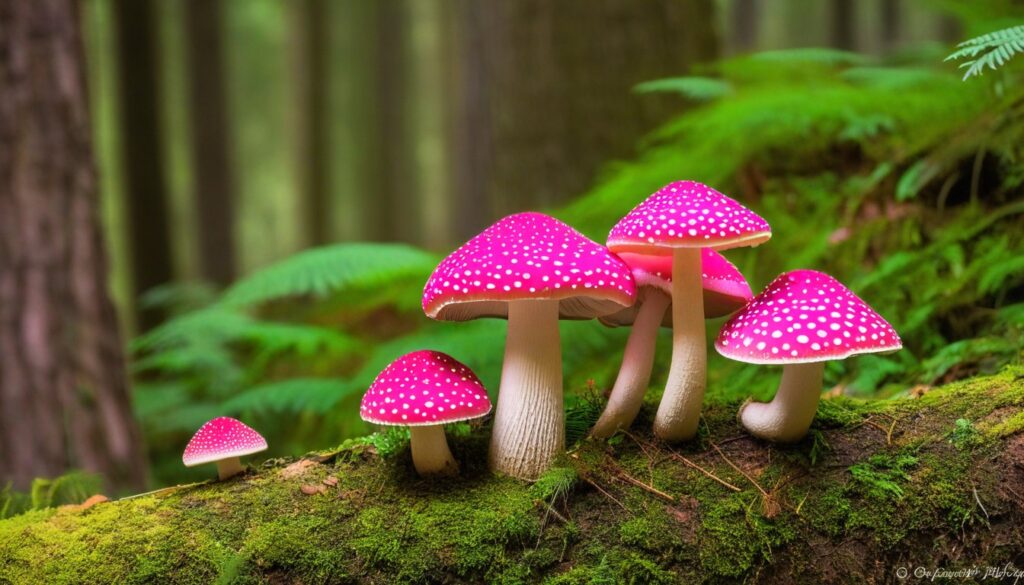If you are a fan of mushrooms, you may have heard about the vibrant and exotic Pink Elephant Mushrooms. These beautiful fungi are known for their striking pink color and unique shape, making them a popular subject for photographers and mushroom enthusiasts alike. In this comprehensive guide, we will delve into everything you need to know about Pink Elephant Mushrooms – from their basic description to their medicinal benefits, traditional uses, and conservation efforts.
Key Takeaways
- Pink Elephant Mushrooms are beautiful fungi known for their vibrant pink color and unique shape.
- They have potential medicinal benefits and are used in traditional medicine practices and culinary recipes.
- Pink Elephant Mushrooms require special care for proper cultivation and pose potential safety hazards if not handled correctly.
- Due to their unique characteristics, Pink Elephant Mushrooms have garnered cultural significance and symbolize various ideas and emotions in folklore.
- Conservation efforts are crucial to promote the sustainability and protection of Pink Elephant Mushrooms and their natural habitats.
What Are Pink Elephant Mushrooms?
Pink Elephant Mushrooms, also known as Pleurotus Djamor, are vibrant fungi with a pinkish-orange hue. These unique mushrooms are native to tropical and subtropical regions, including Asia, Africa, and South America.
The caps of Pink Elephant Mushrooms are fan-shaped and can grow up to 10 centimeters in diameter. They have a velvety texture and often emit a sweet fragrance when fresh. The gills of the mushroom are thin and run down the length of the stem. The stem, which is fibrous and tough, is often shortened to allow the cap to be more prominent. Generally, Pink Elephant Mushrooms are known for their bright color and intriguing shape, which makes them a popular decorative item for various occasions.
These mushrooms, which are also a type of oyster mushroom, are prized for their rich, earthy flavor and meaty texture. They are also incredibly versatile, making them an excellent ingredient for a wide variety of dishes such as stir-fries, soups, stews, and even burgers.
Common Characteristics of Pink Elephant Mushrooms
Characteristic | Description |
|---|---|
Color | Pinkish-orange |
Cap Shape | Fan-shaped |
Size | Up to 10 cm in diameter |
Gill Shape | Thin and run down the length of the stem |
Stem Texture | Fibrous and tough |
Flavor | Earthy and meaty |
Despite their unique and attractive appearance, Pink Elephant Mushrooms are also known for their medicinal properties, making them an important ingredient in traditional medicine practices across the globe. They are also believed to have anti-inflammatory and antioxidant effects, as well as immune-boosting properties. As with all fungi, it is important to exercise caution when consuming Pink Elephant Mushrooms, given the potential for toxicity.
Overall, Pink Elephant Mushrooms are a fascinating and versatile type of fungi that add a pop of color and flavor to any dish. Whether consumed for their taste or their medicinal properties, these mushrooms are an excellent addition to any kitchen or garden.
Habitat and Distribution
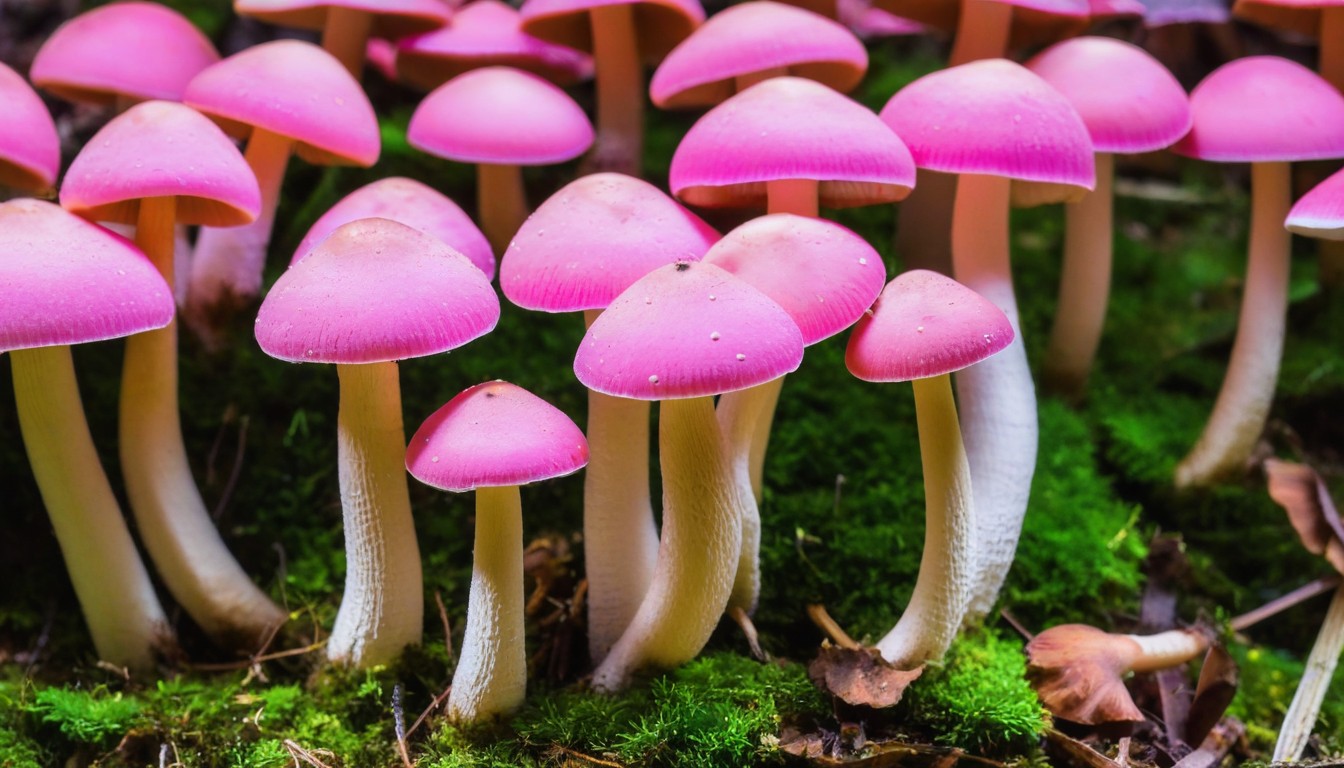
Pink Elephant Mushrooms are a type of gilled fungi that grow naturally in the forests of Southeast Asia, including Thailand, India, and Cambodia. These stunning mushrooms thrive in warm, humid environments, typically growing on dead or decaying wood, especially on sweet gum trees.
Country | Habitat | Climate |
|---|---|---|
Thailand | Forest floors, decaying wood | Tropical |
India | Decaying wood, soil | Tropical to subtropical |
Cambodia | Forest floors, dead wood | Tropical |
However, Pink Elephant Mushrooms have now been spotted growing in other parts of the world, such as the United States, Australia, and the UK. While limited information is available on their exact distribution, it’s believed that they are found in similar environments in these regions as well.
It’s important to note that despite their visually striking appearance, Pink Elephant Mushrooms are not common in the wild and are a rare find. Their habitat and natural distribution are constantly being threatened due to deforestation, habitat loss, and climate change. Therefore, it’s crucial that we take the necessary steps to preserve their natural habitat and ensure their survival for years to come.
Cultivation of Pink Elephant Mushrooms
Cultivating Pink Elephant Mushrooms requires time, patience, and precision. These vibrant fungi require specific conditions to grow and flourish. Here are the steps involved in successfully cultivating Pink Elephant Mushrooms:
- Acquire mushroom spores: Obtain quality mushroom spores from reputable suppliers. Ensure the spores are suitable for cultivating Pink Elephant Mushrooms.
- Prepare the substrate: The substrate is the material where the spores will grow. Choose a substrate that can hold moisture and provide adequate nutrients for the mushrooms. Some examples of suitable substrates include straw, sawdust, or logs. Sterilize the substrate to kill off any potential contaminants.
- Add spores to substrate: Inoculate the substrate with the mushroom spores. This can be done by injecting the spores directly into the substrate or by laying a spore-infused layer on top of the substrate.
- Incubate the substrate: Place the inoculated substrate in a warm, dark location with high humidity. Allow the spores to germinate and establish themselves in the substrate.
- Introduce fruiting conditions: Once the spores have colonized the substrate, introduce the fruiting conditions. These conditions include high humidity and lower temperatures, usually around 60-70°F. Provide fresh air and light to stimulate mushroom growth.
- Harvest the mushrooms: When the mushrooms reach maturity, harvest them by gently twisting and pulling them from the substrate. Avoid damaging the surrounding mushrooms or substrate.
Cultivating Pink Elephant Mushrooms can be a rewarding experience, providing fresh, flavorful mushrooms for culinary purposes or medicinal use. However, it requires careful attention to detail and adherence to proper techniques.
Medicinal Benefits
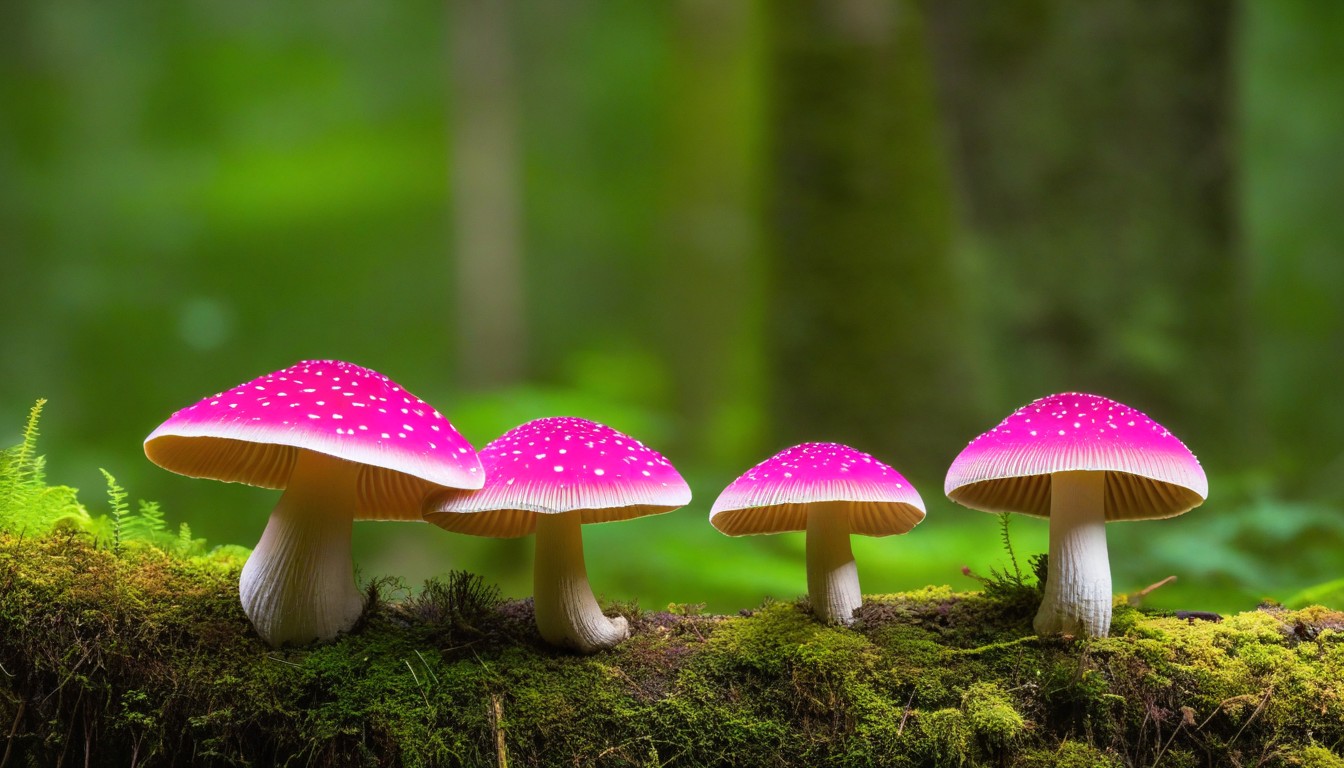
For centuries, Pink Elephant Mushrooms have been used in traditional medicine practices due to their potential medicinal benefits. Rich in antioxidants and anti-inflammatory compounds, these mushrooms may aid in improving immunity, reducing inflammation, and fighting against harmful pathogens.
Preliminary studies have also suggested that Pink Elephant Mushrooms may have anti-cancer properties and could potentially help in managing diabetes. With ongoing research and clinical trials, more health benefits of these vibrant fungi are being discovered.
“Pink Elephant Mushrooms have been valued for their medicinal properties for generations. Now, we are seeing scientific evidence to back up these claims, and they are becoming increasingly popular in modern medicine.” -Dr. Emily Lee, medical researcher
Culinary Uses and Recipes
Pink Elephant Mushrooms are not only visually appealing but also incredibly delicious. These mushrooms are a unique addition to any dish, and their flavor complements a wide variety of ingredients.
One popular way to enjoy Pink Elephant Mushrooms is to sauté them with garlic and butter and serve them as a side dish. These mushrooms also work well in stir-fries, soups, stews, and pasta dishes.
Here are a few Pink Elephant Mushroom recipes to try:
Stuffed Pink Elephant Mushrooms
Ingredients | Instructions |
|---|---|
4 Pink Elephant Mushrooms | 1. Remove the stems and gills from the mushrooms. 2. Brush the caps with olive oil and sprinkle with salt and pepper. 3. Preheat the oven to 375°F. 4. In a small bowl, mix 1 cup of breadcrumbs, 1 cup of grated parmesan cheese, 2 cloves of minced garlic, and 2 tablespoons of melted butter. 5. Stuff the mushroom caps with the breadcrumb mixture. 6. Bake the mushrooms for 20-25 minutes, or until the filling is golden brown and the mushrooms are tender. |
Pink Elephant Mushroom Risotto
Ingredients | Instructions |
|---|---|
1 cup of Arborio rice | 1. In a large saucepan, heat 2 tablespoons of olive oil. 2. Sauté 1 chopped onion and 2 cloves of minced garlic until soft. 3. Add 1 cup of Arborio rice and cook until the rice is coated in oil. 4. Add 1/2 cup of white wine and stir until absorbed. 5. Add 3 cups of chicken or vegetable broth, a ladleful at a time, stirring constantly, until the rice is cooked through. 6. In a separate pan, sauté 1 cup of chopped Pink Elephant Mushrooms in butter until softened. 7. Add the mushrooms to the risotto, along with 1/2 cup of grated parmesan cheese and 2 tablespoons of chopped parsley. 8. Serve immediately. |
Experiment with Pink Elephant Mushrooms in your cooking and discover the unique flavor they have to offer.
Toxicity and Safety Precautions
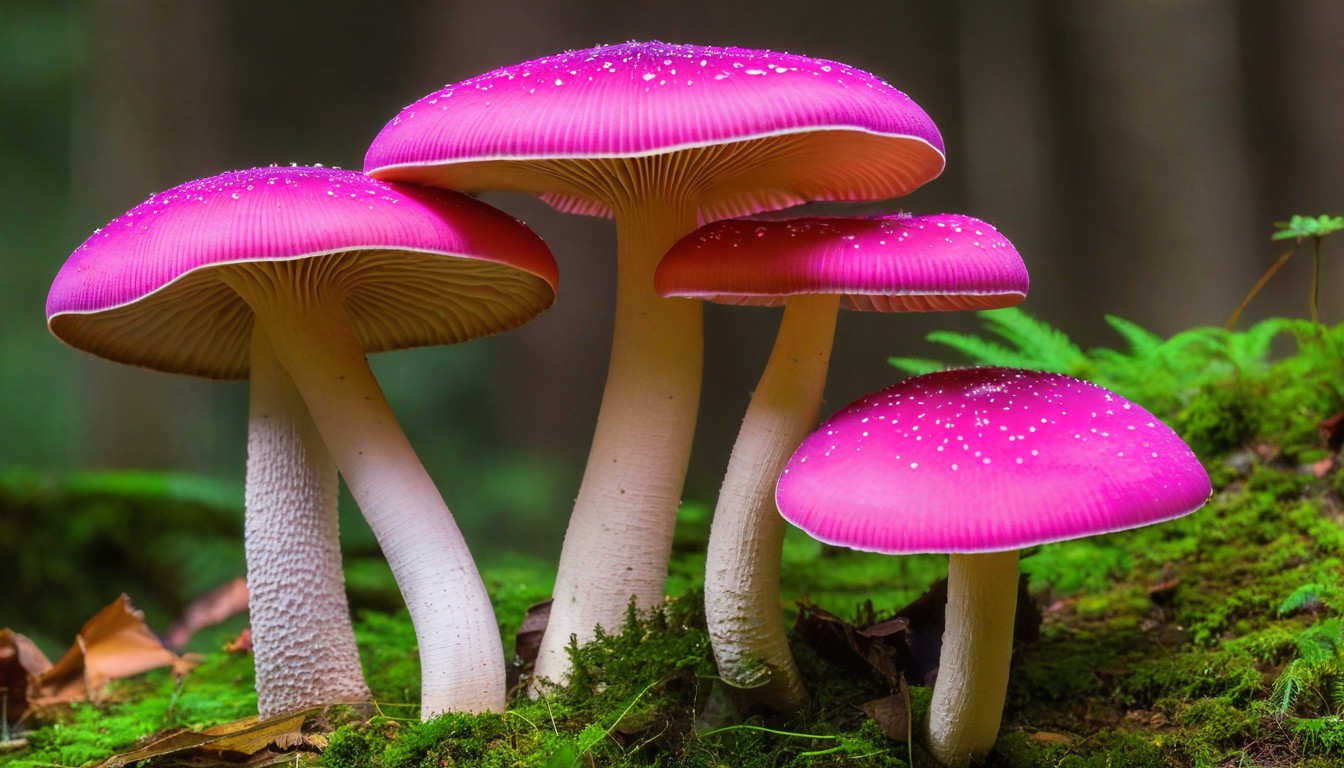
Pink Elephant Mushrooms contain psilocybin, a naturally occurring psychedelic compound that triggers hallucinations and altered perception of reality. While these fungi have been used for medicinal and spiritual purposes for centuries, they also pose some potential health risks if not handled correctly.
Potential Hazards
The primary concern with Pink Elephant Mushrooms is their toxicity level. Consuming too much of these mushrooms can cause serious health problems, such as vomiting, diarrhea, seizures, and coma. Moreover, some people may experience psychotic episodes, anxiety, and paranoia while under the influence of psilocybin.
Pink Elephant Mushrooms can also interact with certain medications, such as antidepressants and antipsychotics, leading to adverse reactions and worsening of symptoms.
Safety Precautions
If you decide to consume Pink Elephant Mushrooms for recreational or spiritual purposes, it is essential to take the necessary safety precautions to minimize the risks. Some of the recommended safety measures include:
- Consume in a safe and familiar environment with trusted companions
- Start with a small dose and gradually increase it to avoid taking too much
- Avoid mixing Pink Elephant Mushrooms with alcohol or other drugs that may interact with psilocybin
- Stay hydrated and monitor your body temperature to prevent dehydration and overheating
- Have a designated sober person to watch over you and seek medical attention if necessary
In conclusion, while Pink Elephant Mushrooms offer a range of health benefits and spiritual insights, it is crucial to understand the potential hazards and take the necessary safety precautions when handling them.
Pink Elephant Mushrooms in Traditional Medicine
Pink Elephant Mushrooms have been used for centuries in traditional medicine practices across different cultures. In traditional Chinese medicine, they are known as ‘Zizhi’ and have been used to treat various conditions, including stomach ailments, liver problems, and inflammation. In Japan, they are known as ‘Karasu-Tengu’ and are believed to have immune-boosting properties.
Native American cultures also recognized the medicinal benefits of Pink Elephant Mushrooms. They were used to treat headaches, fever, and infections, and were also believed to have spiritual healing properties.
Research has shown that Pink Elephant Mushrooms contain polysaccharides and triterpenoids, which have anti-inflammatory, immunomodulatory, and antioxidant properties. These compounds make Pink Elephant Mushrooms a promising candidate for developing new herbal medicines.
It is important to note that while Pink Elephant Mushrooms have potential health benefits, they should not be used as a substitute for medical treatment. Always consult with a healthcare professional before using any natural remedies, including Pink Elephant Mushrooms.
Pink Elephant Mushrooms in Folklore and Symbolism
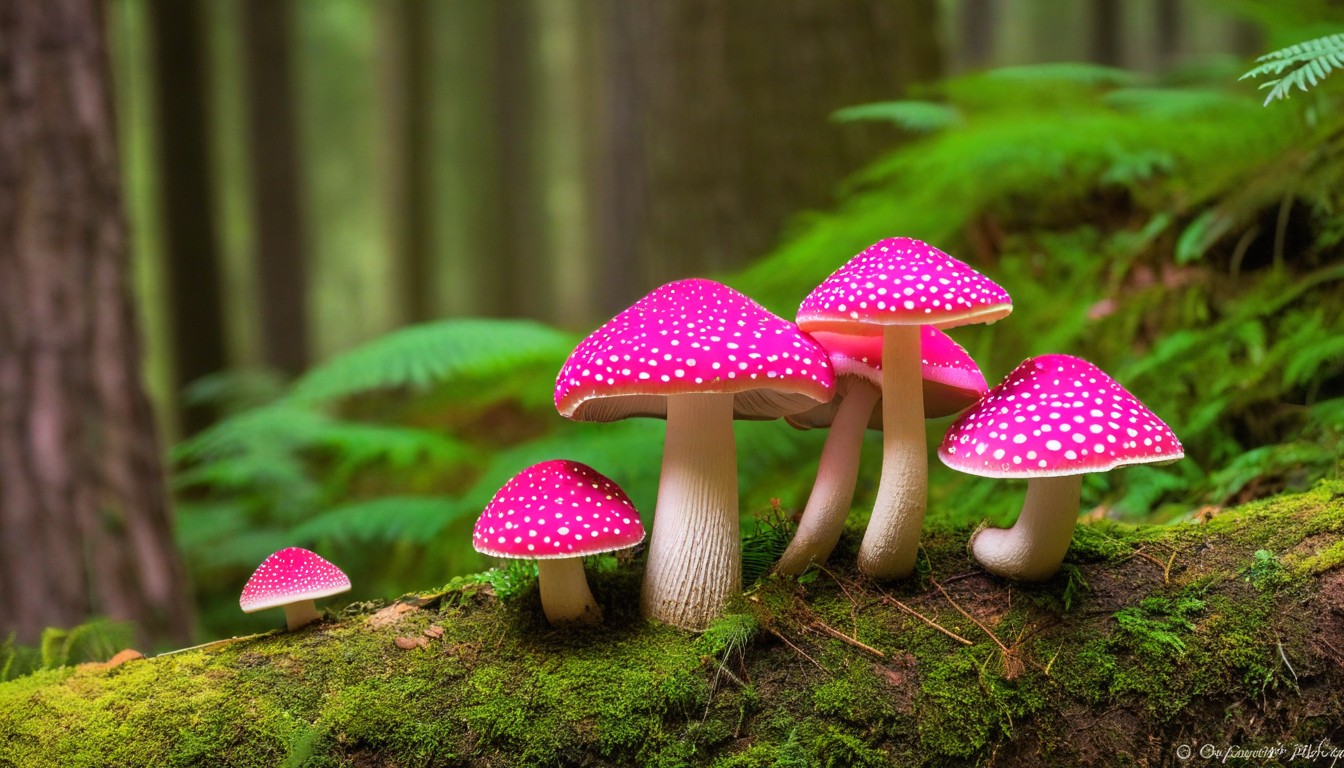
Pink Elephant Mushrooms have long been associated with a rich tapestry of folklore and symbolism that spans cultures and continents. In many indigenous communities, these mushrooms are imbued with mystical powers and are prized for their ability to induce visions and altered states of consciousness.
According to popular legend, consuming Pink Elephant Mushrooms can lead to encounters with otherworldly creatures and spirits. In some cultures, they are regarded as a gateway to the spirit realm and are used in shamanic rituals to connect with ancestral spirits and deities.
“The Pink Elephant Mushroom has been an important part of our traditional medicine and spiritual practices for centuries. It is believed to possess healing properties and can help to unlock profound insights and understanding of the natural world and the cosmos.” – Elder of the Cherokee Nation
Symbolically, Pink Elephant Mushrooms are often associated with creativity, imagination, and intuition. Their vibrant pink color is said to represent the gentle and nurturing energy of the divine feminine, and they are believed to aid in artistic endeavors and creative pursuits.
The Pink Elephant Mushroom in Art and Literature
Throughout history, Pink Elephant Mushrooms have been a popular subject in art and literature. They have appeared in countless paintings, poems, and works of fiction, often depicted as powerful mystical entities or as a source of inspiration for artists and writers.
Work | Artist/Author | Description |
|---|---|---|
The Door in the Wall | H.G. Wells | A story that explores themes of imagination and alternate realities. Contains a reference to Pink Elephant Mushrooms as a symbol of the protagonist’s connection to the spiritual realm. |
The Psychedelic Experience | Timothy Leary | A guidebook for individuals seeking to explore altered states of consciousness. Contains a chapter on Pink Elephant Mushrooms and their role in shamanic traditions. |
Untitled (Pink Elephant Mushroom) | Georgia O’Keeffe | A vibrantly colored painting of a Pink Elephant Mushroom, highlighting the beauty and unique form of the fungi. |
Whether consumed for their symbolic significance, their alleged healing properties, or their vibrant aesthetic appeal, Pink Elephant Mushrooms continue to captivate and inspire people across the globe. As their popularity continues to grow, it is important to remember the cultural significance and respectfully incorporate them into our lives.
Conservation Efforts and Legal Status
Pink Elephant Mushrooms are a rare species found in select regions of the world. Due to their unique characteristics and benefits, the demand for Pink Elephant Mushrooms has increased, making them vulnerable to over-harvesting and extinction. As a result, many countries have implemented conservation efforts to protect these valuable fungi and ensure their sustainability for future generations.
The legal status of Pink Elephant Mushrooms varies by country and region. In some areas, Pink Elephant Mushrooms are classified as a protected species, and their collection and consumption are strictly regulated. In other regions, they are considered an invasive species and deemed harmful to the ecosystem. It is essential to understand the legal status of Pink Elephant Mushrooms in your area and comply with any guidelines or restrictions in place.
Country/Region | Legal Status |
|---|---|
United States | Considered a regulated species in some states, including California and Oregon. Collecting and selling without a license is illegal. |
Canada | Not protected under federal law, but some provinces, such as British Columbia, have regulations in place to manage collection and sale. |
Europe | Depends on the country. In the UK, Pink Elephant Mushrooms are not protected, but in Italy, they are considered endangered. |
Asia | Considered an endangered species in some areas, including China and Japan, with strict laws against harvesting and trading. |
To promote conservation efforts and protect Pink Elephant Mushrooms, it is essential to be mindful of their habitats and practice responsible harvesting techniques. Avoid over-harvesting and leave some specimens behind to reproduce and maintain the population. By respecting the legal status and promoting conservation efforts, we can work together to ensure the sustainability and continued existence of these vibrant fungi.
Conclusion
Pink Elephant Mushrooms are a colorful and intriguing species of fungi that have drawn interest from scientists, cultivators, and enthusiasts alike. As we have learned throughout this article, these mushrooms have a unique set of characteristics, habitats, and medicinal properties that set them apart from other fungi.
From their vibrant appearance and potential health benefits to their historical significance and conservation efforts, Pink Elephant Mushrooms have a lot to offer the world.
Whether you’re interested in cultivating them for culinary or medicinal purposes, it’s essential to understand the potential toxicity and necessary safety precautions associated with these mushrooms. Furthermore, it’s crucial to support conservation efforts to ensure their sustainability for future generations.
Overall, Pink Elephant Mushrooms are an exciting and valuable addition to the world of fungi, and we look forward to continued research and discovery in the years to come.
FAQ
What are Pink Elephant Mushrooms?
Pink Elephant Mushrooms are a species of fungi known for their vibrant pink color and unique appearance. They are scientifically classified as Amanita muscaria var. formosa and are closely related to the Fly Agaric mushroom.
Where are Pink Elephant Mushrooms found?
Pink Elephant Mushrooms are typically found in coniferous forests, particularly in North America, Europe, and Asia. They have a symbiotic relationship with certain tree species, such as pine and birch.
Are Pink Elephant Mushrooms edible?
Pink Elephant Mushrooms are not recommended for consumption as they contain potentially toxic compounds, including muscimol and ibotenic acid. Ingesting these mushrooms can lead to various side effects and health risks.
Can Pink Elephant Mushrooms be cultivated?
While Pink Elephant Mushrooms can be cultivated, it requires specialized knowledge and techniques. The cultivation process involves creating the ideal growing conditions, including the right substrate, temperature, and humidity levels.
Are there any medicinal benefits associated with Pink Elephant Mushrooms?
Pink Elephant Mushrooms have been traditionally used in certain cultures for their potential medicinal properties. They may have anti-inflammatory, analgesic, and antispasmodic effects, but further research is needed to validate these claims.
How can Pink Elephant Mushrooms be used in cooking?
Pink Elephant Mushrooms are not commonly used in culinary practices due to their potential toxicity. It is best to avoid consuming these mushrooms and explore safer alternatives for cooking and gastronomic purposes.
Are Pink Elephant Mushrooms toxic?
Yes, Pink Elephant Mushrooms can be toxic. They contain compounds that can have psychoactive effects on the central nervous system and may cause symptoms such as nausea, vomiting, dizziness, and confusion if ingested.
How are Pink Elephant Mushrooms used in traditional medicine?
Pink Elephant Mushrooms have a history of being used in traditional medicine practices for various purposes, including pain relief, fever reduction, and spiritual rituals. However, it is important to note that these uses are based on folklore and cultural traditions rather than scientific evidence.
Are Pink Elephant Mushrooms linked to any folklore or symbolism?
Pink Elephant Mushrooms are often associated with symbolism in folklore and mythology. They have been depicted in art and literature, representing concepts such as transformation, spiritual experiences, and the realm of the supernatural.
What is the conservation status of Pink Elephant Mushrooms?
Pink Elephant Mushrooms are not specifically listed on conservation status assessments. However, it is important to practice responsible foraging and to protect the natural habitats where these mushrooms grow to ensure their sustainability.

